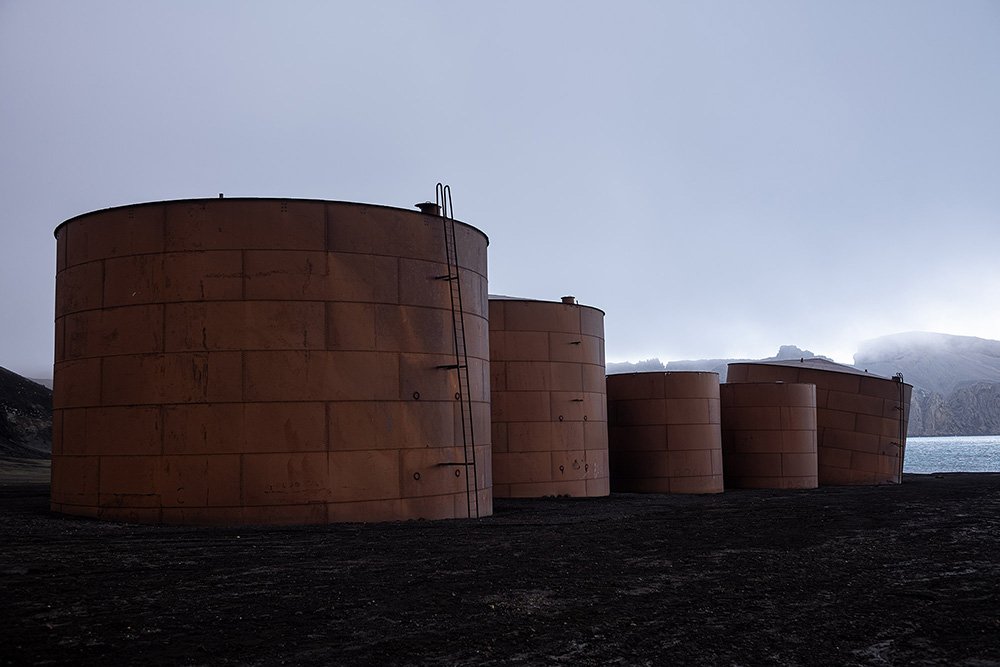
Antarctica chapter three
Yankee Harbor, our first landing (and our first encounter with penguins!).
I feel world’s better. I can’t say whether it was the pill or having found my sea legs.
On my last cruise, around the Galapagos, I felt seasickness on the first day, but was fine by the second. I can attribute the solid night’s sleep to the pill, however.
I take a moment to suss out our position using the map on our closed-circuit TV and come up with an estimate for where and when we might see our first iceberg. I’m on my way to reception to enter my guess when someone mentions that the first iceberg had been sighted around 0600 in the morning. We’ll find out the winner of the contest at the evening briefing.
I climb the stairs up to Deck 8 to take in the view. Eilidh is already outside surveying the sea. She’s on board as a representative of ORCA and will be a familiar sight on the observation deck as she works to spot and catalogue whale sightings. She’ll have a busy trip.
It’s her first time traveling to Antarctica and she’s excited for the trip. Previously, she had spent six months on a ferry between the UK and Norway teaching people about the wildlife there. This is something on a completely different scale. She shows me the app she uses to track her sightings (OceanWatchers) and invites me to download it when I have internet. As a novice, you can make simple identifications, but by taking a course with the organization you can graduate to identifying species with more specificity.
I’m somewhat underdressed to be standing out in the cold with Eilidh and soon take my leave and head down to breakfast, but not before seeing my first albatross, circling the ship.
As I pass through the indoor observation deck I run into Kris, one of the kayak guides. He asks me if I’m interested and I respond with an enthusastic yes. He tells me he’ll see me at the briefing.


On the way to breakfast I check the posted schedule. Our itinerary calls for a day at sea, which I assumed would be light on activities, but the day is packed:
0930 A mandatory briefing for anyone interested in kayaking.
1100 A lecture on the art of polar photography by Tammy, the official expedition photographer.
1230 Lunch.
1400 A lecture charting the fortunes of Roald Amundsen and Robert Scott as they vie to become the first person to reach the south pole by Vide, one of our expedition guides.
1600 afternoon tea.
1700 A lecture on whales in our water by Eilidh.
1815 The captain’s welcome cocktail and our evening briefing.
1900 Dinner.
At the kayaking briefing we’re asked about our prior experience, whether we’re a single kayaker or have a partner in mind, and asked to sign a waiver. For those who are interested, we’ll be broken up into groups and given opportunities to paddle as they become available. The weather is unpredictable, and safety is the primary concern.
I return to deck 8 after the briefing. Eilidh is still standing watch. I meet Tim and Corey in the indoor observation room. He retired 20 days ago and is now on this voyage. I tell him he’s doing retirement right.
Eilidh waves for us to come outside. She’s seen whales. Corey’s super excited to see spouts so close to the ship. Eilidh tells us the deckhand who is with us is good luck. He came out telling her he wanted to see whales and then there they were, off to starboard. An iceberg drifts slowly by to port.
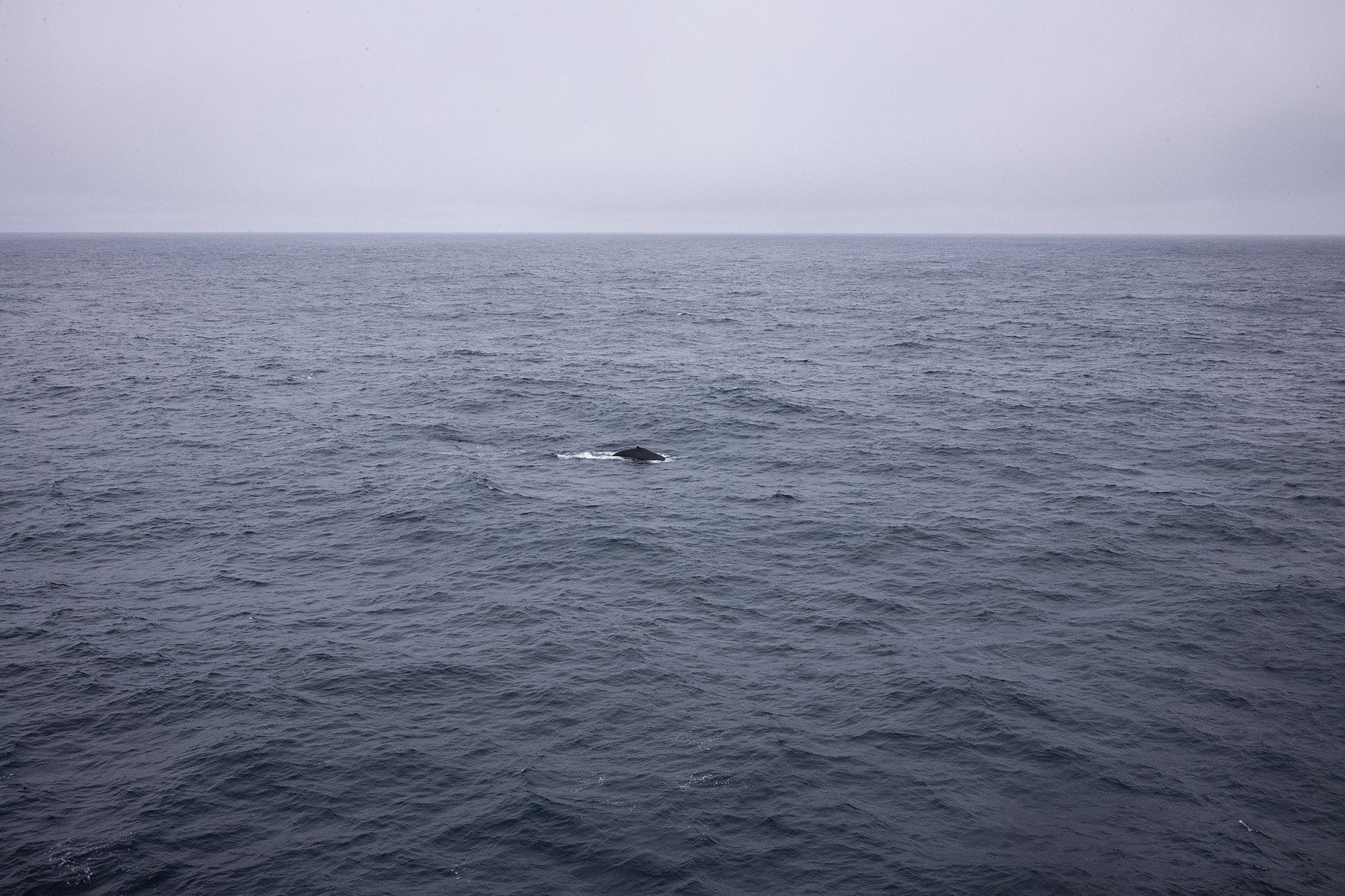


The talk on the art of polar photography is as much about seeing and being present as it is about photography itself. Tammy suggests ways of seeing and encourages us to take time out, to put down the camera in order to immerse ourselves in the experience of being in Antarctica. She eschews technique for thoughtfulness. Dilini later tells me that it is one of her favorite talks.
•
Nearing lunch we’re called for an impromptu briefing. Szymon has a surprise for us. We’ve made such good time (even with our delayed departure) that our first landing has been scheduled for that afternoon. Vide’s talk will be rescheduled.
We’ll see land soon and by 1330 we’ll have reached the South Shetland islands. Our new schedule calls for us to visit Yankee Harbor on the southwest corner of Greenwich Island where a colony of gentoo penguins resides. The rush of excitement is palpable.
•
The South Shetland islands appear as rocky outcroppings on the ocean. The foggy conditions of the morning have cleared and blue skies and clouds crown the snowy islands and peaks.
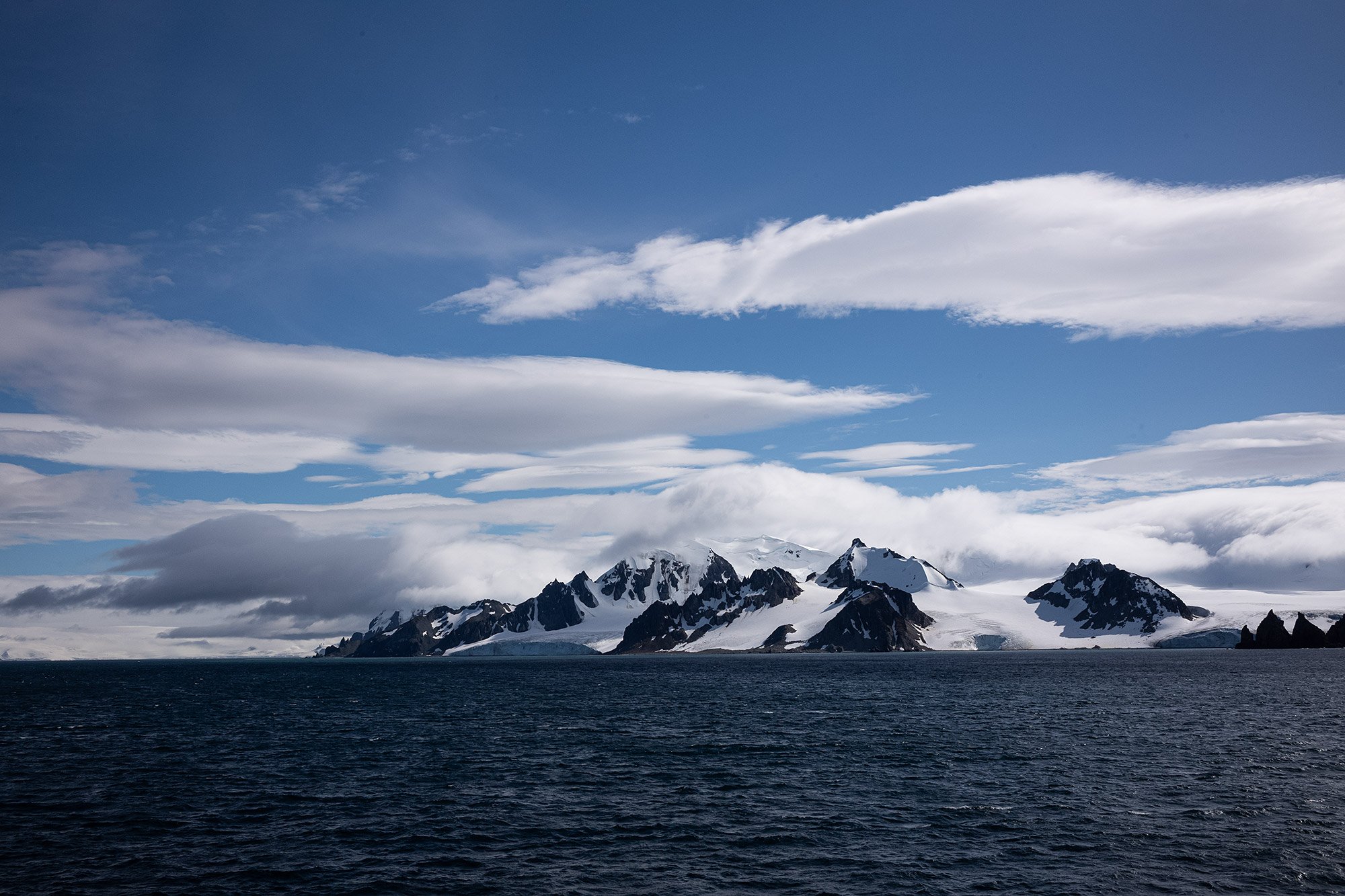


The Drake Passage was my first experience sailing on the open sea, but it wasn’t long enough to make the sight of land seem unusual. Still, it feels like something new and the landscape is just a taste of what’s to come as we sail further down the penninsula.
As we sail towards the land someone shouts out. There’s a humpback whale practically astride the ship. We rush to the railings to get a better view. I think I’ve missed it until I see it resurface and blow, sending sea spray into the air. We can clearly see the shape of its body and fins below the water as it moves lazily past us. It’s my first close encounter with one and I almost forget my camera as I gaze at upon its magestic form.
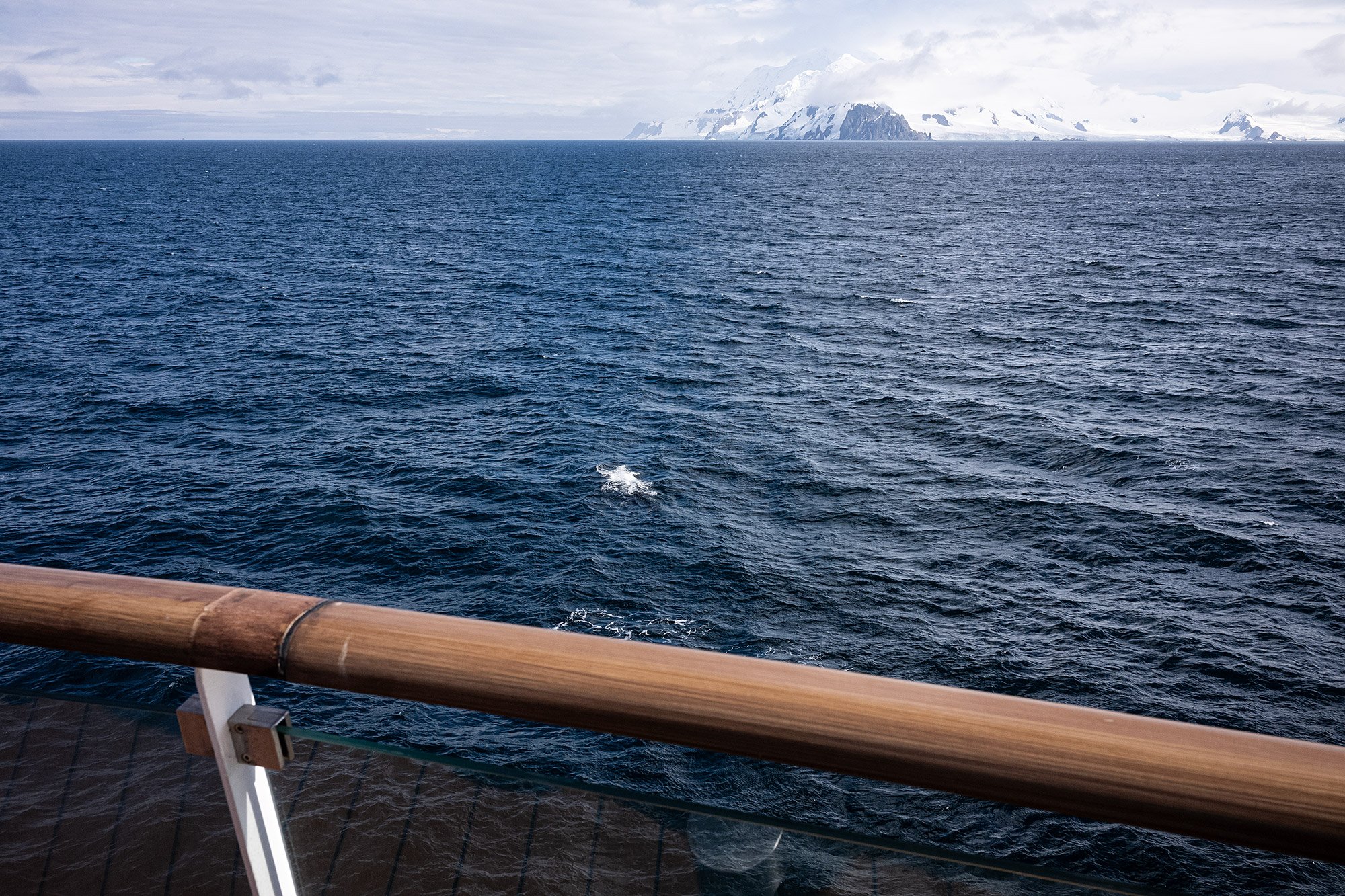

We soon reach the harbor and the engines quiet. The scent of penguin guano permeates the air. It’s a scent we’ll come to know well.
From my balcony I watch as zodiacs are lowered into the water. The expedition team sets out to assess the conditions and to mark out a path with flags; crossed flags mark areas beyond which we are not to roam. We’re reminded to keep our distance from the wildlife, understanding that the penguin chicks may be curious and wander up to us. We’re told to slowly back away to give them space. We’re also told to give way and let them pass if they look to be crossing ahead.



I don my clothes—a merino wool base layer I’ve purchased on board, having realized I had neglected to pack one; a fleece; a set of thermal bottoms; a pair of wind- and water- resistant exercise pants; waterproof rain bib pants borrowed from Carlos; the expedition parka; a neck gaiter, hat, and gloves—and wait for my group to be called.
Fully dressed, I stand out on my balcony to watch the guides navigate the bay on zodiacs. A small crew is left on the island to watch out after us; the rest are tasked with ferrying us to and from the landing point. I can hear my neighbors getting ready, calling out to each other; I’m in the same color group as the family to my left.
I’ve met my neighbors briefly. To my right is an older Swiss-Italian man traveling alone. He speaks no English or Spanish; French is his preferred language. His wife doesn’t like to travel and so he finds himself sailing solo. I’ve forgotten most of what little French I once knew, but try to exchange pleasantries.
To my left is a Chinese couple from the mainland and their 11.5 year-old daughter Vivian. It’s a joy having her on board. She’s vivacious and curious, wanting to explore and learn about everything. She speaks English, but is shy about it, and between chatting with her, her family, and the other Chinese citizens on board I find myself speaking more Chinese on this trip than I’ve spoken in years.
The green group is called to the mudroom and I quickly check to see that I have everything I need. My camera slips neatly into a magnetically-sealed pocket of my parka and I slip my ID card and room key into a convenient see-through pouch on my sleeve.
The tail end of the red group, which is where they’ve placed the Chinese tour group, is finishing up their preparations and boarding zodiacs. I change my sneakers out for rubber boots, donning a pair of woolen socks a cousin had given to me for Christmas years before; it’s the first time I’ve had use for them and they turn out to be the perfect fit and gift. Finally, I put on my life jacket.
I line up with a group of Chinese people by the door that leads to the zodiacs. We’re counted out and our ID cards are scanned. We’re told to give our boots a rinse in a pink solution to kill bacteria from them and then sent to board a zodiac. We’re reminded to use a seaman’s grip (hand to forearm) with the guides and crew who help us board, and then we’re off.



As we approach the shore we can see penguins and fur seals dotting the landscape. Our fellow passengers line the horizon, spread out on the beach. In their uniform blue expedition parkas they feel almost like part of the fauna of the island.
Before disembarking we’re reminded how to disembark, sliding to the bow of the zodiac and then turning with our legs pointed aft. We’re also reminded to keep our distance from the animals and to stay within the route outlined by the red flags. Finally, we’re told how much time we have before we need to return to the landing site to be zodiaced back to the ship; it’s never enough time.
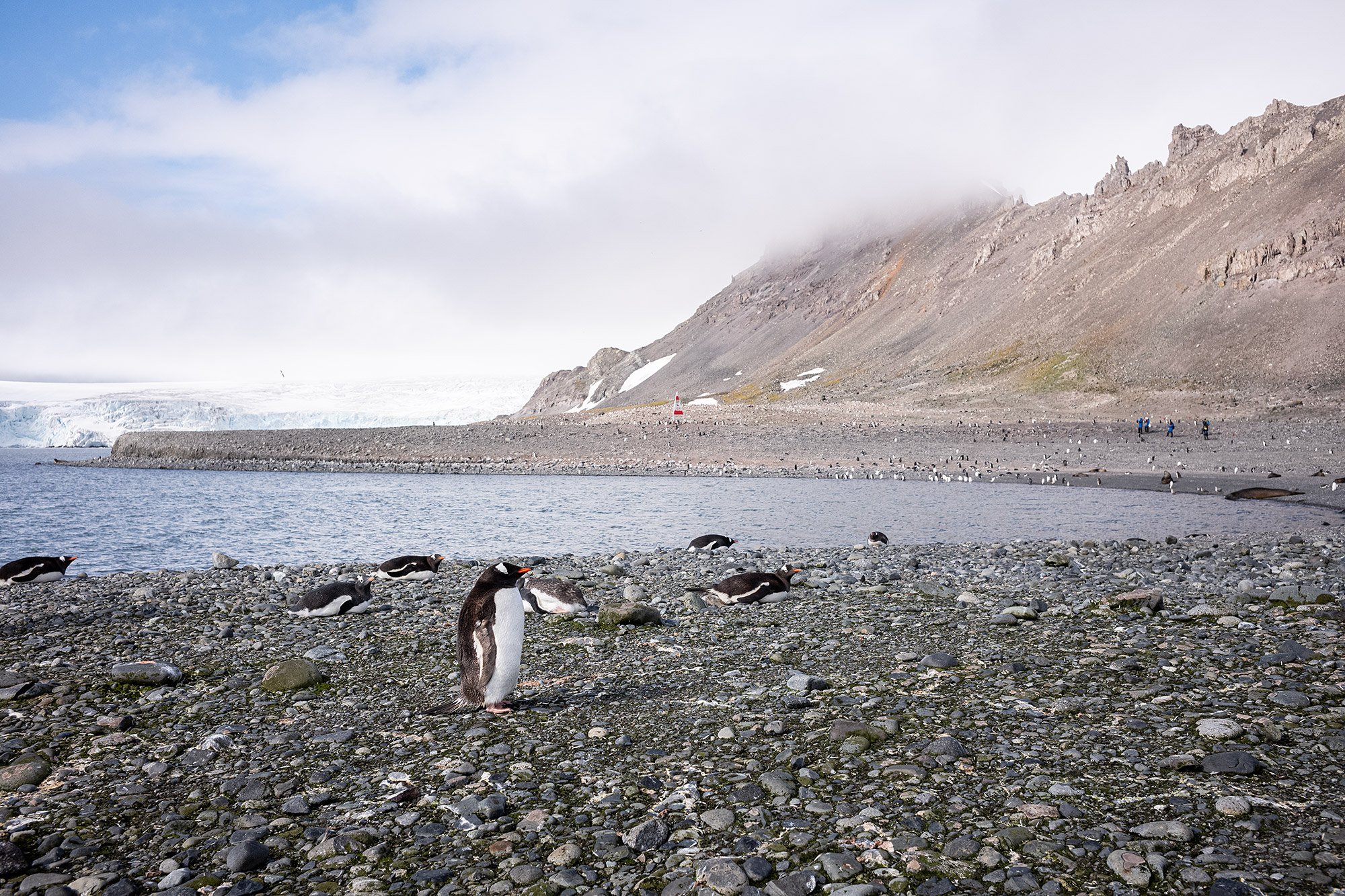


I walk along the path set for us towards a small ridge overlooking a freshwater lake that marks the boundary of our exploration. I stop to chat with Dave, one of our expedition guides who hails from Canada. Vivian approaches us and starts pelting Dave with questions about the penguins, which he answers one after another, happy to explain anything to her.
After she wanders off, we wonder at her curiosity and the breadth of her questions. Later, I’ll hear her explain everything to her parents in Chinese. I eagerly share this with Dave to let him know that his patience is being rewarded in spades.





On the island, the chicks are feeding and molting. They chase their parents around for food and we watch as they are fed, the parents regurgitating food into their chicks’ mouths. Some are flopped down on their bellies, as if they can’t be bothered to move. Others move in what seem to be small small packs, picking their way lightly upon the rocky shore.








All too soon, it’s time to return to the ship. I say goodbye to Dave and retrace my steps to the landing site, pausing to let the penguins who cross my path pass.

Back on board, we scrub our boots in a specially-designed tray before rinsing them once again with pink liquid. Our IDs are scanned and I doff my boots, carefully placing my socks in each with enough space to make sure air will circulate.
In my cabin, I take each layer of clothing off and hang them in my closet or on the hooks in the room. Dressed for the captain’s welcome cocktail, I linger on the balcony to take in the view and watch as guides bring the last passengers back to the ship. Once their task is complete, I watch as they wait in their zodiacs to be hoisted on board.
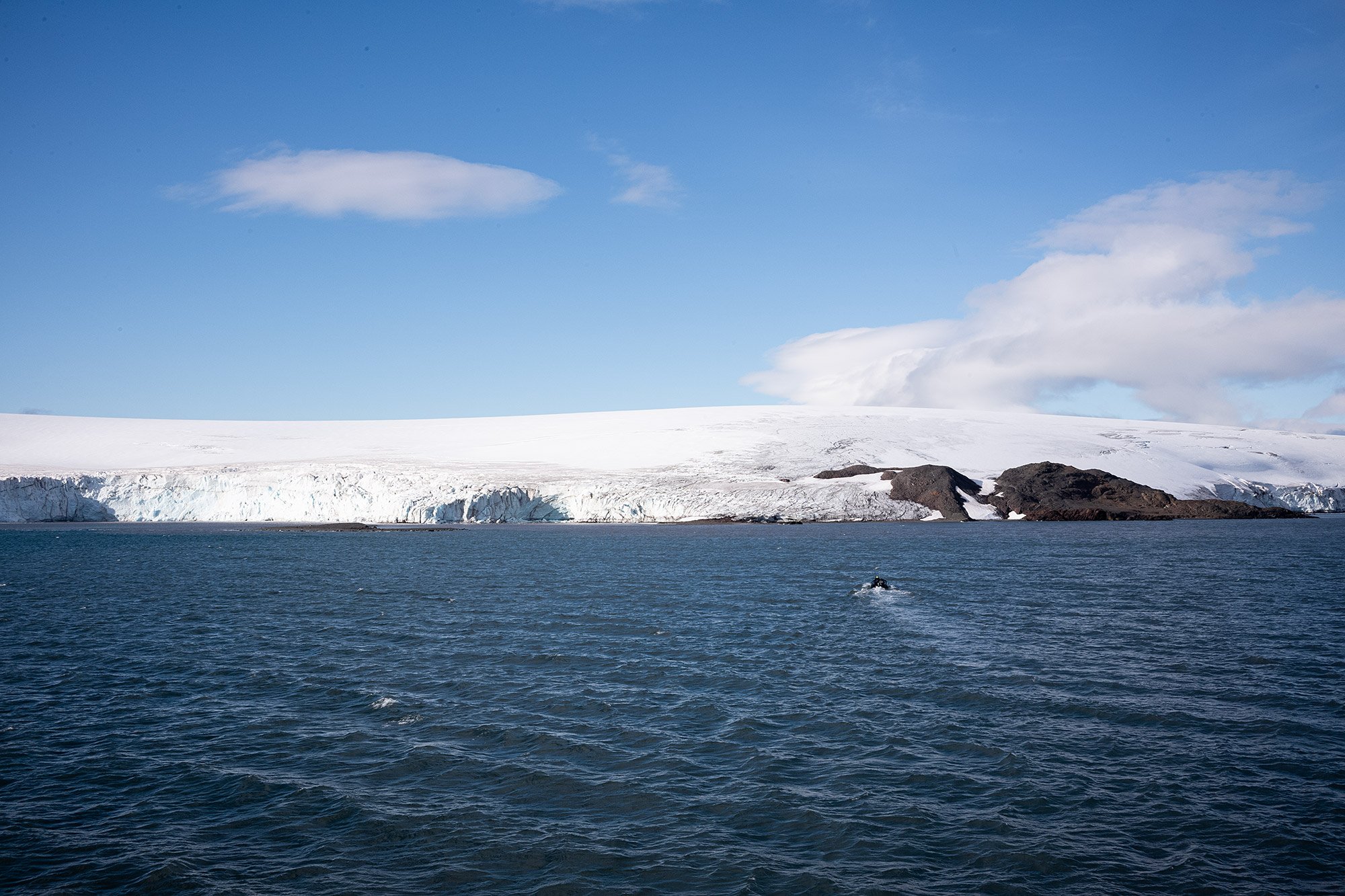


I find Dilini and Ellie by the bar as I head down for the captain’s welcome cocktail and evening briefing. They’ve dressed for the occasion and I am in one of the better outfits I’ve brought on board. I pick up a glass of sparkling wine and we look for seats in the conference room.
The captain, Boris, brings his officers up and introduces them to us. He tells us that while they’re responsible for the navigation and making sure we arrive and depart safely, he’s handing the responsibility of the weather to us. He’s taken care of the amazing day we’ve had; he hopes we’ll be able to keep it up.
During one of the briefings, we were given a brief history of the continent and how it’s managed. It’s currently governed by about 30 countries, all of which are parties of the 1959 Antarctic Treaty System. Of those who live on the continent by far the largest population is comprised of scientists and researchers.
As we toast, the captain leaves us with this: There are only professionals no politicians in Antarctica. That’s why it’s not a mess.
During the briefing they announce the winner of the iceberg contest. It’s Vivian, the girl who lives next door. She wins a plush toy and she stands at the front of the room holding it front of her as her parents take photos. I can’t think of a person I’d have wanted to win more.
Tomorrow’s wake up call is at 0615. 🇦🇶
20 February 2024













